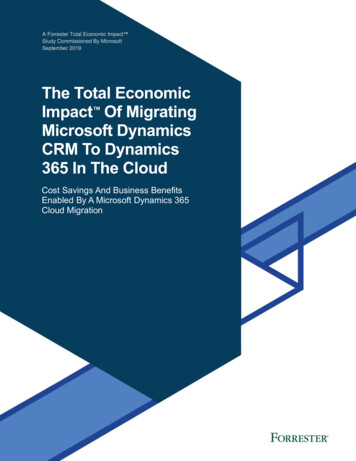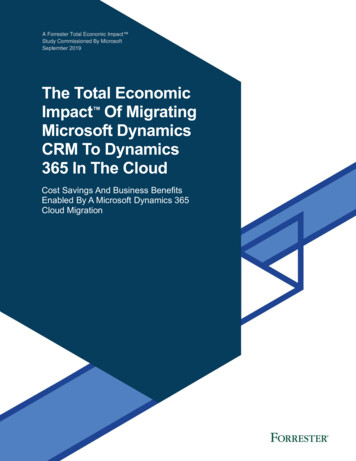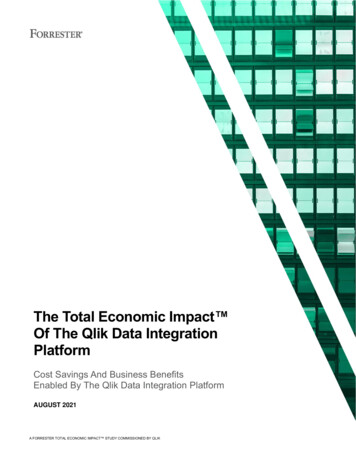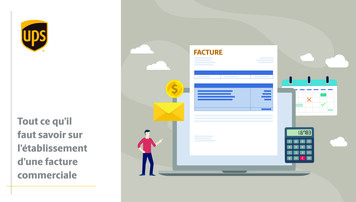
Transcription
A Forrester Total Economic Impact Study Commissioned By MicrosoftSeptember 2019The Total EconomicImpact Of MigratingMicrosoft DynamicsCRM To Dynamics365 In The CloudCost Savings And Business BenefitsEnabled By A Microsoft Dynamics 365Cloud Migration
Table Of ContentsExecutive SummaryKey FindingsTEI Framework And MethodologyCustomer JourneyInterviewed Organizations344Decision Drivers4Key Results5Composite Organization5Analysis Of BenefitsAvoided On-Premises User Licensing And Support CostsProject Director:Benjamin Brown1167Avoided On-Premises Data Center Costs8CRM Administration Savings9Low-Code Customization Efficiency11Seller Onboarding12Seller Productivity13Seller Effectiveness14Sales Manager Productivity14Customer Service Agent Productivity15Customer Service Manager Productivity16Unquantified Benefits17Flexibility18Analysis Of CostsSubscriptions1919Cloud Migration20Biannual Updates21User Training21Financial SummaryMicrosoft Dynamics 365 Cloud Migration: OverviewAppendix A: Total Economic ImpactAppendix B: Endnotes23242526ABOUT FORRESTER CONSULTINGForrester Consulting provides independent and objective research-based consulting to helpleaders succeed in their organizations. Ranging in scope from a short strategy session tocustom projects, Forrester’s Consulting services connect you directly with researchanalysts who apply expert insight to your specific business challenges. For moreinformation, visit forrester.com/consulting. 2019, Forrester Research, Inc. All rights reserved. Unauthorized reproductionis strictly prohibited. Information is based on best available resources.Opinions reflect judgment at the time and are subject to change. Forrester ,Technographics , Forrester Wave, RoleView, TechRadar, and Total Economic Impact aretrademarks of Forrester Research, Inc. All other trademarks are the property of theirrespective companies. For additional information, go to forrester.com.
Executive Summary7% TCO reductionIT savings of migrating fromDynamics CRM 2013 toDynamics 365 in the cloud63% ROIIncluding both IT savings andimpacts to end users10 monthsPayback period“Dynamics 365 is thebackbone, the foundation.It’s a must-have — there’sno way we could run ourbusiness without it.”Global marketing programsmanager, professional servicesMicrosoft Dynamics 365 is a suite of integrated business applications thatcan underpin essential business processes for customers from sales tofield service and from finance to retail. Microsoft commissioned ForresterConsulting to conduct a Total Economic Impact study examining thepotential return on investment (ROI) organizations may realize bymigrating on-premises deployments of Dynamics CRM to Dynamics 365 inthe cloud. This study’s purpose is to provide a framework for readers toevaluate the potential financial impact of a migration at their organizations.To better understand the benefits, costs, and risks associated with thisinvestment, Forrester interviewed four customers who migrated from onpremises Dynamics CRM 2011 or 2013 to Dynamics 365. Intervieweesinvested in these migrations to overcome stale and, in some cases, highlycustomized environments that were expensive to maintain and difficult touse. By migrating, interviewees aimed to reduce administrative cost andlabor, enhance data collection, adopt new capabilities, improve userexperience (UX), and ultimately drive long-term business growth.Key FindingsInterviewed customers either matched or marginally reduced their CRM’stotal cost of ownership (TCO) by migrating from CRM 2011 or CRM 2013to Dynamics 365 in the cloud. Forrester’s model found a typical TCOreduction of 7% as the cloud migration helps organizations:› Avoid on-premises user licensing and support costs. These includeClient Access License (CAL) purchases for new users and annualsoftware assurance costs. Migrations also generally reduce partnerindependent software vendor (ISV) and managed services costs due tothe additional functionality included in Dynamics 365 along with thesimplicity of the cloud.› Avoid on-premises data center costs. One-time hardware, storage,networking, and software costs for server refreshes would have cost 60,249 per server, while ongoing heating, cooling, electric, andmaintenance costs would have cost 29,912 per server, per year.› Reallocate CRM administration labor. Cloud migrations simplify CRMadministration, reduce data entry and validation, and eliminate hardwareadministration needs — saving labor costs and empowering employeesto refocus on more impactful work instead of “keeping the lights on.”› Recapture CRM developer labor. Power users can work on forms,fields, and workflows with low-code customization — freeing 30% ofCRM developers’ expensive time for more complex, high-impact tasks.To find the true Total Economic Impact of such a migration, it’s essential tolook beyond IT savings as a TCO-only analysis neglects the mostimportant benefits of the cloud migration: the impacts for end users.Forrester modeled a 63% ROI for a Dynamics 365 cloud migration on aworkforce of sales and customer service users, as organizations:› Shorten onboarding for new sellers by one week. Not only do newhires benefit from Dynamics 365’s easier-to-learn user interface, butthey also benefit as user CRM adoption and usage increases —improving data depth, accuracy, and quantity in the CRM.1 The Total Economic Impact Of Migrating Microsoft Dynamics CRM To Dynamics 365 In The Cloud
“[Dynamics 365] is providingefficiency, productivity gains,and helping us provide a betterservice for our clients — ithelps us fulfill our promises.”CRM manager,real estate› Boost seller productivity. With a global CRM accessible on the go andimproved data collection, reminders, and sync, sellers increasedreusability of proposals and meeting decks by 4%, increased mobileproductivity by 8%, and reduced time spent on data entry by 4%.› Increase seller effectiveness. Using data, reminders, personalization,and reusability, sellers can provide better service and ultimately increasetheir sales performance by at least 1%.› Improve sales manager productivity. Consolidated data, dashboards,and automated reporting help managers increase productivity for tasksof monitoring team performance and updating leadership by 20%.› Boost customer service agent productivity. Agents become 3% moreproductive and deliver better service with the new UX and enriched data.Modeled financialimpact for acomposite organizationBenefits PV 5.7 millionCosts PV 3.5 millionNPV 2.2 million 5.7MBenefits10 monthsPayback period 3.5MCostsInitialYear 1Year 2Year 3› Improve customer service manager productivity. Managers canavoid after-hours or weekend office work to address issues throughmobile access and improved systems tracking and automation.Interviewees also explained that users reported greater satisfaction withthe new user experience and features, driving adoption and regular usage.Organizations collected more data with better detail and accuracy, helpinggenerate new insights, enhance decision making, and improve businessoutcomes — and leveraging Power BI, PowerApps, AI, and machinelearning amplified the impact. Dynamics 365 also strengthened securityand helped organizations achieve and prove compliance with keyregulations, especially the General Data Protection Regulation (GDPR).And finally, migrating to Dynamics 365 Field Service helped resolve issuesmore quickly and with fewer labor hours.Migrating to the cloud also opened the door to future opportunities thatcould help organizations scale, change strategy, or take on new businessopportunities. Companies can immediately gain access to the newestDynamics 365 features rather than waiting for them to reach on-premisesversions, and the flexibility of consuming the range of Microsoft’s solutionsfrom the cloud with a subscription model can help these organizationsquickly scale users, add Dynamics modules, and adopt and integrate otherMicrosoft offerings (such as Office 365) or ISV solutions.Interviewed customers identified four key cost categories for theirmigrations, which Forrester modeled to calculate TCO savings and returnon investment. Migration timelines (and cost) varied substantially betweenthree to 18 months, depending on the environment’s complexity. Forresterestimates that a typical migration requires six months with a 33% risk ofdelays, incurring both internal labor and partner migration services costsplus several hours of training per end user. Enterprises that meet minimumseat requirements may be eligible for Microsoft’s FastTrack program,which provides services and tools to accelerate and simplify the cloudmigration for virtually no cost aside from nominal Azure staging costs.Beyond the migration, administration was simpler than before with the onlynew ongoing cost of labor and professional services being the testing anddeployment of Microsoft’s biannual upgrades.To evaluate the Total Economic Impact of such a cloud migration,Forrester constructed a TEI framework, a composite organization, and anassociated ROI analysis based on the four interviewed organizations. Thiscomposite organization reduces the TCO of its CRM by 7% over threeyears, with IT savings of 3.7 million versus costs of 3.5 million. Themigration also drove 1.9 million in benefits to end users for a three-year,risk-adjusted ROI of 63% and a net present value (NPV) of 2.2 million.2 The Total Economic Impact Of Migrating Microsoft Dynamics CRM To Dynamics 365 In The Cloud
TEI Framework And MethodologyFrom the information provided in the interviews, Forrester has constructeda Total Economic Impact (TEI) framework for those organizationsconsidering upgrading on-premises deployments of Microsoft DynamicsCRM to Microsoft Dynamics 365 in the cloud.The objective of the framework is to identify the cost, benefit, flexibility, andrisk factors that affect the investment decision. Forrester took a multistepapproach to evaluate the impact that a Dynamics 365 cloud migration canhave on an organization:The TEI methodologyhelps companiesdemonstrate, justify,and realize thetangible value of ITinitiatives to bothsenior managementand other keybusinessstakeholders.DUE DILIGENCEInterviewed Microsoft stakeholders and Forrester analysts to gather datarelative to Dynamics 365 cloud migrations.CUSTOMER INTERVIEWSInterviewed four organizations who migrated to Dynamics 365 in the cloudto obtain data with respect to costs, benefits, and risks.COMPOSITE ORGANIZATIONDesigned a composite organization based on characteristics of theinterviewed organizations.FINANCIAL MODEL FRAMEWORKConstructed a financial model representative of the interviews using theTEI methodology and risk-adjusted the financial model based on issuesand concerns of the interviewed organizations.CASE STUDYEmployed four fundamental elements of TEI in modeling a Dynamics 365cloud migration’s impact: benefits, costs, flexibility, and risks. Given theincreasing sophistication that enterprises have regarding ROI analysesrelated to IT investments, Forrester’s TEI methodology serves to provide acomplete picture of the total economic impact of purchase decisions.Please see Appendix A for additional information on the TEI methodology.DISCLOSURESReaders should be aware of the following:This study is commissioned by Microsoft and delivered by Forrester Consulting.It is not meant to be used as a competitive analysis.Forrester makes no assumptions as to the potential ROI that otherorganizations will receive. Forrester strongly advises that readers use their ownestimates within the framework provided in the report to determine theappropriateness of an investment in Microsoft Dynamics 365.Microsoft reviewed and provided feedback to Forrester, but Forrester maintainseditorial control over the study and its findings and does not accept changes tothe study that contradict Forrester’s findings or obscure the meaning of thestudy.Microsoft provided the customer names for the interviews but did not participatein the interviews.3 The Total Economic Impact Of Migrating Microsoft Dynamics CRM To Dynamics 365 In The Cloud
Customer JourneyBEFORE AND AFTER MIGRATING TO DYNAMICS 365 IN THE CLOUDInterviewed OrganizationsFor this study, Forrester interviewed four organizations that migratedfrom on-premises versions of Microsoft Dynamics CRM 2011 or CRM2013 to Dynamics 365 in the cloud. Interviewed customers include:INDUSTRYREGIONINTERVIEWEESIZECLOUD MIGRATIONLocalgovernmentEuropeCRM project manager1,500 employees400 Dynamics usersCRM 2011 to Dynamics 365Real estateNorth AmericaCRM manager15,000 employees500 Dynamics usersCRM 2011 to Dynamics Online2013 to Dynamics 365ManufacturingEuropeHead of market toorder applications15,000 employees1,000 Dynamics usersCRM 2013 to Dynamics 365ProfessionalservicesNorth AmericaGlobal marketingprograms manager20,000 employees3,400 Dynamics usersCRM 2013 to Dynamics 365Decision DriversInterviewees decided to migrate from their on-premises Dynamics CRMdeployments to Dynamics 365 in the cloud for several key reasons:› Take advantage of new features as soon as they are released. Thelocal government CRM project manager explained: “An immediateversion upgrade was very important. We had fallen so far behind onversions. We did a version just two weeks ago, so we know that we areleveraging the very best of Dynamics 365.” The professional servicesglobal marketing programs manager echoed: “When we first moved toDynamics in 2014, going with the cloud wasn’t an option leadershipwould consider [due to security concerns]. So we launched onpremises, but it wasn’t too long after we launched that the cloud-firstmentality hit our company. . . . We were consistently a step behindbecause now it’s always cloud-first development.”› Allow IT to stop “fighting fires” and instead add new businessvalue. Maintaining on-premises hardware and legacy code requiressignificant internal and professional services labor. Shifting to the cloudenables those employees to shift to further application developmentand more interesting work that could benefit the business in the longrun. The local government CRM project manager explained: “We hadlost a lot of our staff, and [leadership] felt that we were spending toomuch time maintaining equipment. We moved to the cloud to releasestaff to work on projects and implementing new things as opposed toconstantly firefighting, to leverage the best technology that we could,and to enable flexibility like allowing people to work from home.”› Shift to a cloud cost model for improved cash flow, scalability,and flexibility. Interviewees were unsure whether to expect TCOreductions as they were simultaneously expanding; however, theylooked to control and better predict their cash flow with a cloud model.As they grew, they wanted a product and pricing model that couldquickly and predictably adapt to changing user counts, seasonality,and use cases.“The ROI is certainly there.There’s no way we could runour business withoutsomething like Dynamics withthe global scale of our usersand our business.”Global marketing programsmanager, professional services“The advantage of the cloud isyou always get the newestversion and the newestfunctions, and they really workin the system.”Head of market to orderapplications, manufacturing4 The Total Economic Impact Of Migrating Microsoft Dynamics CRM To Dynamics 365 In The Cloud
Key ResultsInterviewed organizations achieved the following key results by migratingto Dynamics 365 in the cloud.› Reduced total cost of ownership marginally, while gaining capabilities.› Simplified IT administration and reduced complex development needs.› Improved user experience, productivity, and effectiveness.› Enhanced scalability, flexibility, and agility.Composite OrganizationBased on the interviews, Forrester constructed a TEI framework, acomposite company, and an associated ROI analysis that illustrates theareas financially affected. The composite organization is representativeof the four companies that Forrester interviewed and is used to presentthe aggregate financial analysis in the next section.The composite organization that Forrester synthesized from thecustomer interviews:› Previously ran Dynamics CRM 2013 on-premises for five years.› Migrates to Dynamics 365 Sales and Dynamics 365 Customer Serviceover a six-month period.› Leverages Microsoft FastTrack for Dynamics 365 to accelerate andreduce migration costs. FastTrack is a customer success service fromMicrosoft that assists cloud migrations for qualified customers.› Works with a third-party partner to assist with migration planning,implementation, and customization of Dynamics 365.› Deploys Dynamics 365 Sales to 600 sellers, 150 sales managers, and20 business and IT administrators.› Deploys Dynamics 365 Customer Service to 200 customer serviceagents, 50 customer service managers, and 20 business and ITadministrators.› Experiences 5% year-over-year growth in number of users as thebusiness grows.In the following analysis, Forrester modeled the three-year financialimpact of this cloud migration for the composite organization using thedata from the four customer interviews.Composite organizationcharacteristics:› Migration from DynamicsCRM 2013 to Dynamics365 Sales and Dynamics365 Customer Service› 600 sellers› 150 sales managers› 200 customer serviceagents› 50 customer servicemanagers› 20 IT and crossfunctional administrators5 The Total Economic Impact Of Migrating Microsoft Dynamics CRM To Dynamics 365 In The Cloud
Analysis Of BenefitsQUANTIFIED BENEFIT DATA AS APPLIED TO THE COMPOSITEForrester modeled the financial impact of migrating from an on-premises deployment of Dynamics CRM2013 to Dynamics 365 in the cloud for the composite organization based on the key findings from thecustomer interviews. This section discusses the quantified benefits of such a migration, with the costsection following. The following tables and accompanying text detail the cash flow by benefit categoryover a three-year period. The calculations incorporate risk adjustment, and the table shows the presentvalue (PV) of each benefit at a 10% annual discount rate. More information for each benefit is availablein the corresponding section using the category’s name or the reference letter (column labeled “Ref.”).Quantified total cost of ownership (TCO) savings. The composite organization achieves thefollowing three-year risk-adjusted present value (PV) cost savings:› Avoids 1.0 million in user licensing and support costs. This includes Client Access License(CAL) purchases for new users, annual software assurance costs, and reduced partner costs.› Avoids 1.1 million in data center costs. Savings across nine servers in three sites include onetime avoided server refreshes at 60,249 per server plus 29,912 in annual costs per server.› Reallocates 1.4 million of CRM administration labor. By Year 2, the composite organizationreallocates three IT administrators, two CRM developers, and two CRM specialists.› Recaptures 214,428 in CRM developer labor by enabling low-code customization. Thecomposite’s four CRM developers free up 30% of their time for more complex, high-impact tasks.Total Cost Of Ownership SavingsRef.BenefitYear 1Year 2Year 3TotalPresentValueAtrAvoided on-premises user licensing andsupport costs 350,070 425,713 445,291 1,221,074 1,004,628BtrAvoided on-premises data center costs 770,877 255,748 255,748 1,282,372 1,104,305CtrCRM administration savings 337,500 696,600 696,600 1,730,700 1,405,887DtrLow-code customization efficiency 109,350 72,900 72,900 255,150 214,428 1,567,797 1,450,961 1,470,538 4,489,296 3,729,248Quantified end user benefits. The composite organization recognizes the following three-year riskEtrSelleronboarding 102,000 112,880 322,320adjustedPV benefitsfor end users in sales and customerservice 107,440roles: 266,329Subtotal: Reduced TCOSelleronboardingproductivity for new sellers by one week, 129,792 272,992 353,024 755,808 608,838› FtrShortensrecapturing 266,329in added value.Thecomposite150 new hires faster based on a 100,125600-person salesforcea 25% annualturnover. 431,317GtrSeller rampseffectiveness 210,596 and 221,276 531,998› HtrImprovesproductivity,in added 76,235value. The 600sellers increaseSales sellermanagerproductivity recapturing 608,838 36,192 80,110 192,537sales collateral reusability by 4%, increase mobile productivity by 8%, and reduce data entry time byItrCustomer service agent productivity 90,000 189,000 198,894 477,8944%. 156,094 387,449Customerservicemanager productivity 42,930 107,731 87,360› JtrIncreasessellereffectiveness,yielding 431,317 20,250of increasedoperating 44,550profit. The composite’s600 sellersincreasetheiraverage n.Subtotal: End user benefits 478,359 899,194 1,010,735 2,388,288 1,937,387› Improves sales manager productivity, recapturing 156,094 in added value. The composite’s150 managersincreaseproductivity by 20% for monitoringreporting tasks.Total benefits(risk-adjusted) 2,046,156 and 2,350,155 2,481,273 6,877,584› Improves customer service agent productivity, recapturing 387,449 in added value. Thecomposite’s 200 agents become 3% more productive with the new UX and enriched data.› Improves customer service manager productivity, recapturing 87,360 in added value. Thecomposite’s 50 customer service managers avoid six 8-hour days per year with mobile access.6 The Total Economic Impact Of Migrating Microsoft Dynamics CRM To Dynamics 365 In The Cloud 5,666,635
End User BenefitsRef.BenefitYear 1Year 2Year 3TotalPresentValueEtrSeller onboarding 102,000 107,440 112,880 322,320 266,329FtrSeller productivity 129,792 272,992 353,024 755,808 608,838GtrSeller effectiveness 100,125 210,596 221,276 531,998 431,317HtrSales manager productivity 36,192 76,235 80,110 192,537 156,094ItrCustomer service agent productivity 90,000 189,000 198,894 477,894 387,449JtrCustomer service manager productivity 20,250 42,930 44,550 107,731 87,360 478,359 899,194 1,010,735 2,388,288 1,937,387 2,046,156 2,350,155 2,481,273 6,877,584 5,666,635Subtotal: End user benefitsTotal benefits (risk-adjusted)TCO savings and end user benefits combine for a three-year presentvalue total benefit of 5,666,635 for the composite organization.66% 5.7 millionTotal benefitsBenefitsThree-year, risk-adjusted present values34% 1.4M 1.1M 1.9 millionEnd user benefits 1.0M 3.7 millionReduced TCO 609K 431K 214KAvoided on- Avoided onCRMLow-codepremises user premises data administration customizationlicensing and center costssavingsefficiencysupport costsReduced total cost of ownership: 3.7 million in benefits 387K 266K 156KSelleronboardingSellerproductivitySellerSales manager Customereffectiveness productivity service agentproductivity 87KCustomerservicemanagerproductivityImpact to sales and customer service end users: 1.9 million in benefitsREDUCED TOTAL COST OF OWNERSHIPAvoided On-Premises User LicensingAnd Support CostsOn-premises deployments of Dynamics CRM required purchase ofperpetual per-user Client Access Licenses with annualized maintenancefees known as Software Assurance from Microsoft, levied as apercentage of total license value. By migrating to the cloud,organizations avoided further purchases of these legacy licenses andceased spending on their annual maintenance costs.7 The Total Economic Impact Of Migrating Microsoft Dynamics CRM To Dynamics 365 In The Cloud
Forrester’s model of the composite organization includes 1,020 users —1,000 end users plus 20 business and IT administrative users — whichgrows by 5% annually. The organization therefore avoids just over 50new CRM 2013 license purchases at list price in Years 2 and 3 andavoids the annual software assurance costs for all user licenses. Further,while the composite organization still works with third-party managedservice providers and independent software vendors, it trims thisspending by reducing customizations and complexity in the cloud.The amount of avoided license, maintenance, and partner costs will varyby organization depending on number of users, types of licenses,environment complexity, customization, and desired support level.Forrester adjusted this benefit downward by 5% to account for risks andvariability, yielding a three-year, risk-adjusted cumulative total of 1,221,074 and a PV of 1,004,628 for the composite organization.18% 1.0 millionthree-yearbenefit PVAvoided on-premises userlicensing and support costs:18% of total benefitsAvoided On-Premises User Licensing And Support Costs: Calculation TableRef.MetricCalculationYear 1Year 2Year 3A1Total number of professional users5% annual growth1,0201,0711,125A2Avoided Dynamics CRM 2013 CALsList pricing 0 63,699 67,446A3Avoided software assurance costsList pricing 318,495 334,420 351,281A4Reduction to ISV and managed services costsForrester estimate 50,000 50,000 50,000AtAvoided on-premises user licensing and support costsA2 A3 A4 368,495 448,119 468,727Risk adjustment 5% 350,070 425,713 445,291AtrAvoided on-premises user licensing and support costs(risk-adjusted)Three-year, risk-adjusted cumulative total for thecomposite organization: 1,221,074Three-year, risk-adjusted present value for thecomposite organization: 1,004,628Avoided On-Premises Data Center CostsMoving to the cloud allowed organizations to retire or repurpose existinghardware that previously supported their on-premises deployments. Theinterviewed organizations avoided additional hardware refresh purchasesand related upfront costs for when servers reached end of life along withthe various ongoing costs such as electricity, heating, cooling, andsoftware support associated with running hardware in the data center. 1.1 millionthree-yearbenefit PVUsing a combination of customer interview data and Forrester marketdata, Forrester modeled the avoided data center costs for the compositeorganization using the following assumptions: 119%› The legacy environment required nine servers spread across threesites (three servers per site) to support its major global markets.› Servers had reached end of life after five years of the CRM 2013implementation. The organization therefore avoids investing in ninereplacement servers with the following costs per server: 20,000 in server hardware.Avoided on-premisesdata center costs: 19%of total benefits 4,000 in network equipment. 15,000 in storage costs. 2,500 in operating system licenses. 11,249 in licenses for the operating system, management,security, disaster recovery, and Dynamics CRM Server 2013.8 The Total Economic Impact Of Migrating Microsoft Dynamics CRM To Dynamics 365 In The Cloud
› The organization also avoids the following annual costs per server forthese nine servers: 9,750 in maintenance costs. 15,600 in power, cooling, and facilities costs. 4,562 in maintenance costs for server software and softwareassurance costs for Dynamics CRM Server 2013 licenses.Initial and ongoing data center costs will vary by company depending onits deployment size, global presence, the specific hardware and softwareselected, and regional costs for space, heating, cooling, and electricity.Should recommended replacements have been delayed if theenvironment was not migrated, then replacement costs would not havebeen otherwise incurred — meaning the costs would not actually havebeen avoided. Forrester adjusted this benefit downward by 5% toaccount for these risks and variability, yielding a three-year, risk-adjustedcumulative total of 1,282,372 and a PV of 1,104,305 for the compositeorganization.Impact risk is the risk that thebusiness or technology needs ofthe organization may not be met bythe investment, resulting in loweroverall total benefits. The greaterthe uncertainty, the wider thepotential range of outcomes forbenefit estimates.Avoided On-Premises Data Center Costs: Calculation TableRef.MetricCalculationB1Server replacements avoidedCustomer interviewsB2Hardware costs per new serverForrester estimateB3Avoided server hardwareB1*B2B4Software costs per new serverForrester estimateB5Avoided server licensesB1*B4B6Number of servers decommissionedB1, annualizedB7Ongoing costs per serverForrester estimateB8Avoided ongoing server costsBtBtrYear 2Year 3999 29,912 29,912 29,912B6*B7 269,208 269,208 269,208Avoided on-premises data center costsB3 B5 B8 811,449 269,208 269,208Risk adjustment 5% 770,877 255,748 255,748Avoided on-premises data center costs (risk-adjusted)Three-year, risk-adjusted cumulative total for thecomposite organization: 1,282,372Year 19 39,000 351,000 21,249 191,241Three-year, risk-adjusted present value for the compositeorganization: 1,104,305CRM Administration SavingsAdministrative labor savings were not only the largest financial benefit forthe interviewed organizations, but they also resonated the most with theinterviewees. By migrating to the cloud, organizations eliminatedsubstantial maintenance, support, development, and data managementlabor previously required to keep their CRM systems running. Majorfactors that drove administrative savings include: 1.4 millionthree-yearbenefit PV› Eliminated data center management.› Significantly reduced labor for Dynamics support and enhancement,including configuration, customization, and user management.› Significantly reduced custom development needs with usage of out-ofthe-box capabilities and “citizen development” rather than fully customscripting for simple forms, fields, and similar elements.25%CRM administration savings:25% of total benefits9 The Total Economic Impact Of Migrating Microsoft Dynamics CRM To Dynamics 365 In The Cloud
› Significantly reduced data reentry and verification with a unifiedenvironment and seamless Office 365 integrations — driving CRMadoption.› Reduced labor for data analysis and reporting with better data capture,improved visibility, and enhanced reporting, especially for compliance.Interviewees also identified that any upgrades to their older systemsrequired
Not only do new hires benefit from Dynamics 365's easier-to-learn user interface, but they also benefit as user CRM adoption and usage increases — improving data depth, accuracy, and quantity in the CRM. 7% TCO reduction IT savings of migrating from Dynamics CRM 2013 to Dynamics 365 in the cloud 63% ROI











